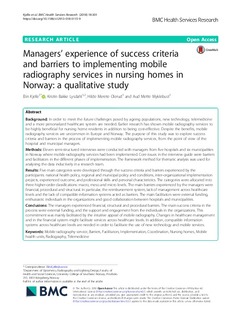| dc.contributor.author | Kjelle, Elin | |
| dc.contributor.author | Lysdahl, Kristin Bakke | |
| dc.contributor.author | Olerud, Hilde M | |
| dc.contributor.author | Myklebust, Aud Mette | |
| dc.date.accessioned | 2018-10-05T06:53:39Z | |
| dc.date.available | 2018-10-05T06:53:39Z | |
| dc.date.created | 2018-07-17T10:59:37Z | |
| dc.date.issued | 2018 | |
| dc.identifier.citation | BMC Health Services Research. 2018, 18:301, 1-12 | nb_NO |
| dc.identifier.issn | 1472-6963 | |
| dc.identifier.uri | http://hdl.handle.net/11250/2566545 | |
| dc.description | This article is distributed under the terms of the Creative Commons Attribution 4.0 International License, which permits unrestricted use, distribution, and reproduction in any medium, provided you give appropriate credit to the original author(s) and the source, provide a link to the Creative Commons license, and indicate if changes were made. The Creative Commons Public Domain Dedication waiver applies to the data made available in this article, unless otherwise stated. | nb_NO |
| dc.description.abstract | Background
In order to meet the future challenges posed by ageing populations, new technology, telemedicine and a more personalized healthcare system are needed. Earlier research has shown mobile radiography services to be highly beneficial for nursing home residents in addition to being cost-effective. Despite the benefits, mobile radiography services are uncommon in Europe and Norway. The purpose of this study was to explore success criteria and barriers in the process of implementing mobile radiography services, from the point of view of the hospital and municipal managers.
Methods
Eleven semi-structured interviews were conducted with managers from five hospitals and six municipalities in Norway where mobile radiography services had been implemented. Core issues in the interview guide were barriers and facilitators in the different phases of implementation. The framework method for thematic analysis was used for analysing the data inductively in a research team.
Results
Five main categories were developed through the success criteria and barriers experienced by the participants: national health policy, regional and municipal policy and conditions, inter-organizational implementation projects, experienced outcome, and professional skills and personal characteristics. The categories were allocated into three higher-order classifications: macro, meso and micro levels. The main barriers experienced by the managers were financial, procedural and structural. In particular, the reimbursement system, lack of management across healthcare levels and the lack of compatible information systems acted as barriers. The main facilitators were external funding, enthusiastic individuals in the organizations and good collaboration between hospitals and municipalities.
Conclusions
The managers experienced financial, structural and procedural barriers. The main success criteria in the process were external funding, and the support and engagement from the individuals in the organizations. This commitment was mainly facilitated by the intuitive appeal of mobile radiography. Changes in healthcare management and in the financial system might facilitate services across healthcare levels. In addition, compatible information systems across healthcare levels are needed in order to facilitate the use of new technology and mobile services. | nb_NO |
| dc.description.sponsorship | This study was funded as part of a PhD-fellowship at the University College of Southeast Norway. The funding body did not participate in the in the design of the study and collection, analysis, and interpretation of data and in writing the manuscript. | nb_NO |
| dc.language.iso | eng | nb_NO |
| dc.publisher | Springer Nature | nb_NO |
| dc.rights | Navngivelse 4.0 Internasjonal | * |
| dc.rights.uri | http://creativecommons.org/licenses/by/4.0/deed.no | * |
| dc.title | Managers' experience of success criteria and barriers to implementing mobile radiography services in nursing homes in Norway: A qualitative study | nb_NO |
| dc.title.alternative | Managers' experience of success criteria and barriers to implementing mobile radiography services in nursing homes in Norway: A qualitative study | nb_NO |
| dc.type | Journal article | nb_NO |
| dc.type | Peer reviewed | nb_NO |
| dc.description.version | publishedVersion | nb_NO |
| dc.rights.holder | (c) 2018 The Authors | nb_NO |
| dc.source.pagenumber | 1-12 | nb_NO |
| dc.source.volume | 18:301 | nb_NO |
| dc.source.journal | BMC Health Services Research | nb_NO |
| dc.source.issue | 1 | nb_NO |
| dc.identifier.doi | 10.1186/s12913-018-3115-9 | |
| dc.identifier.cristin | 1597590 | |
| cristin.unitcode | 222,56,2,0 | |
| cristin.unitname | Institutt for optometri, radiografi og lysdesign | |
| cristin.ispublished | true | |
| cristin.fulltext | original | |
| cristin.qualitycode | 2 | |

